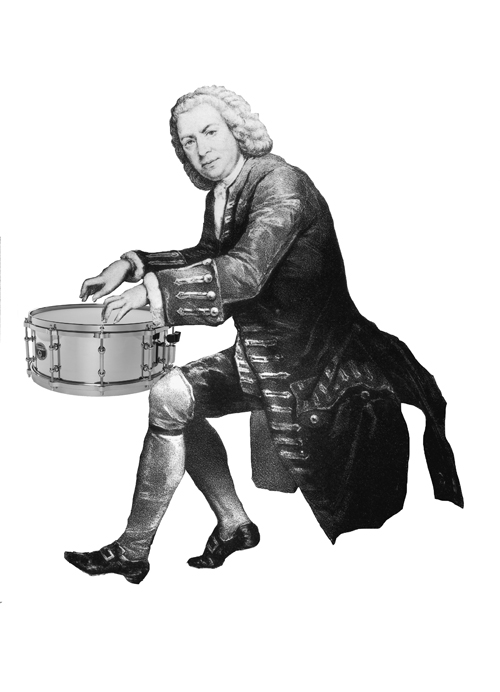
![]() Listen on Wurfsendung / Deutschlandradio
Listen on Wurfsendung / Deutschlandradio
Observing very famous classic musical themes, the so-called evergreens, I’m wondering what makes them so special. Is it a matter of melodiousness? Probably yes. Of orchestral arrangement? Probably not (since at that time the orchestration had standard parameters). But what would happen if we create melodies employing the same notes of Mozart’s Rondo a la Turk, then changing its rhytmical sense completely, i.e. giving different accents which scramble the natural development of the melody itself? Very probably we would obtain something not so impressive, unworthy of making history.
On the contrary, an experiment done with several different listeners confirms that some themes are immediately recognizable because of their rhythm.
THE COMPOSERS’ SESSIONS, produced for the Deutschlandradio’s Wurfsendung format, are a series of very short pieces, which focus mainly on rhythms taken out from very famous classic melodies.
Themes by Mozart, Bach, Beethoven, and many other distinguished colleagues (of theirs) are played on an enlarged jazz drum-set, simply focusing on their rhytmical structures.
A parallel conceptual level, made of natural sounds, dialogues with the drummer, sometimes in a descriptive way (like in Antonio Vivaldi’s Spring or in George Bizet’s Carmen); in other cases natural sounds assume the role of pure rhythmical elements (Johann Strauss’ Blue Danube, Anonymous’ Greensleeves) or they create abstract and surrealistic associations of meanings.
Nevertheless, every single piece can be interpreted as a sort of pure simple sound-action in search of a primitive sense(less?) contest made of basic archetypical geometrical forms like point, line, square, circle, and so on.
S.G. 2015
THE COMPOSERS’ SESSIONS
Structure
1. WOLFGANG. Sounds of a horse approaching and stopping. Main theme from Wolfgang Amadeus Mozart’s Symphony No. 40 – Molto Allegro. Sounds of the horse getting away. Dur. 44”
2. SEBASTIAN. A mason works whistling for the whole length of the piece. Main theme from Jahann Sebastian Bach’s Notebooks for Anna Magdalena Bach – Minuet in G Major.
Dur. 29”
3. ANTONIO. Main theme from Antonio Vivaldi’s Four Seasons – Spring. Some seconds after the beginning some birds’ sounds fade in and play until the end of the piece.
Dur. 41”
4. FREDERIC. Main theme from Frederic Chopin’s Sonata No. 2 – Funeral March. Some seconds after the beginning a man starts coughing, until the end of the piece.
Dur. 43”
5. GEORGE. A bull’s bellow resounds here and there for the whole length of the piece. Main theme from George Bizet’s Carmen – Habanera.
Dur. 33”
6. GIACOMO. Main theme from Giacomo Puccini’s Butterfly – Humming Chorus. Somebody pours some tea into a cup and drinks it in little sips, until the end of the piece.
Dur. 41”
7. GUSTAV. Main theme from Gustav Holst’s The Planets – Mars. Here and there sounds of cars’ horns
Dur. 32”
8. JOHANN. Main theme from Johann Strauss II’s The Blue Danube. The following natural sounds are employed: an old coffee-grinder, a launched coin spinning on the table, an octagone wodden music toy (each side of the octagone makes a different sounding tone when tapped by a small wodden ball spinning inside).
Dur. 38”
9. MODEST. Sounds of a man walking on a floor, at the same tempo of Modest Mussorgskij’s Pictures at an Exhibition – Promenade
Dur. 31”
10. ANONYMOUS. Sounds of somebody sharpening an schyte for the whole length of the piece, at the same tempo of Greensleeves theme.
Dur. 43”
11. GIUSEPPE. Sounds of glasses stroked until the end of the piece. Main theme from Giuseppe Verdi’s La Traviata – Libiamo ne’ lieti calici. The piece ends with glasses clinging.
Dur. 33”
12. LUDWIG. Main theme from Ludwig Van Beethoven: Fifth Symphony – Allegro con Brio. A Harley & Davidson motor-bike turns on, accelerate, and leaves.
Dur. 33”
Every single piece is introduced by a different voice of a different age (male, female, child) which reinforces the idea of universality which lies behind every single musical theme.
Idea and elaborations by Stefano Giannotti
Drums: Tobias Dutschke
Sound-engineer: Jean-Boris Szymczak at Studio P4, Funkhaus Berlin
Produced for Deutschlandradio Kultur – Wurfsendung
Redaction: Julia Tieke
Total length: 7:08”
There are other versions of THE COMPOSERS’ SESSIONS. One of these has been arranged for the students of Music reading at the Scuola di Musica Sinfonia in Lucca.
Scuola di Musica Sinfonia, giugno 2015
